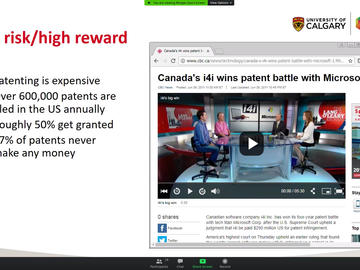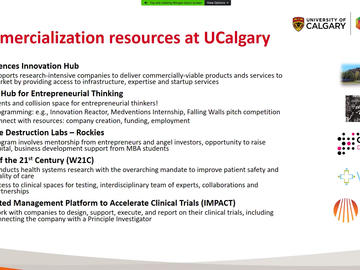Jan. 18, 2021
HPI Intellectual Property and Commercialization Workshop
Are you interested in knowing how to transform an idea or ideas into lasting and safeguarded impact? Well, you need to know about intellectual property rights. These are rights to intangible aspects like inventions, insights, choices, data, or creative material. They can be protected as patents, trademarks, copyrights, and trade secrets. Innovate Calgary explained each of these terms in detail during the HPI Commercialization Workshop held on December 15th, 2020.
Patent protection allows monopoly on machine, method, or new chemical. It starts with a rigorous patent search using online tools like World Intellectual Property Organization (WIPO), Canadian Intellectual Property Office (CIPO), Google Patents, among others. Patent searching can provide knowledge like what countries are of primary interest, competitor(s), or license intelligence such as how likely is one able to file, legal opinion of a product, or if the process or service infringes any patents owned by others. To achieve this, three important requirements for a patent are key: novelty : 1) the invention must be new, does not already exist, and has not already been described anywhere in the world at the time of application; 2)the invention must be useful — must have practical utility and the invention description must be “enabling” with adequate detail to allow someone else to produce it; 3)the invention must be non-obvious — there must be an identifiable inventive step which creates a difference between the invention and the prior art (existing public knowledge).
On the other hand, a trademark is a word, phrase, or symbol used to distinguish a product or service from others in the marketplace. It prevents similar sounding product or service names. A trademark can be registered ® or unregistered ™. A copyright, ©, protects the original expression of an idea but does not protect the idea itself or rephrasing of the same idea. It is suitable for creative work: photos, music, video, source code, journal article, questionnaire, etc. Finally, a trade secret is a valuable secret, kept highly confidential to protect a procedure or process to a novel invention. This secret is flexible and never gets published. It is good for source code, recipes, manufacture methods, etc.
Let us get closer to our area of research. What about microbiology and parasitology inventions? Pre-existing phenomena and creations of nature (e.g., genes, receptors, naturally occurring microorganisms, etc.), are NOT patentable. What could then be patentable in our research? Products produced by microorganisms like antibiotics, enzymes, methods (such as fermentation, process of cultivation etc.), assays, and techniques (primer sequences, analytical methods, etc.) can be patented. Modified microorganisms (recombinant strains) produced by a technical process for a specific application can also be patented. Examples include probiotics and their use, oil-eating bacteria, phosphate solubilizing fungal strains, therapeutic compositions of bacteria (microbiota), etc.
We learn every day! Thank you, Jim Wilson, Morgan Guo, and Megha Bajaj from Innovate Calgary, and HPI for facilitating the informative workshop! Thanks to HPI TOC members, Blanca Callejas and Affan Siddiq for organizing yet another valuable workshop.
Members of the University of Calgary who are interested in translating their research, partnering with industry, or starting a technology-based company can get in touch with Innovate Calgary for more information.
Happy New Year! 😊



